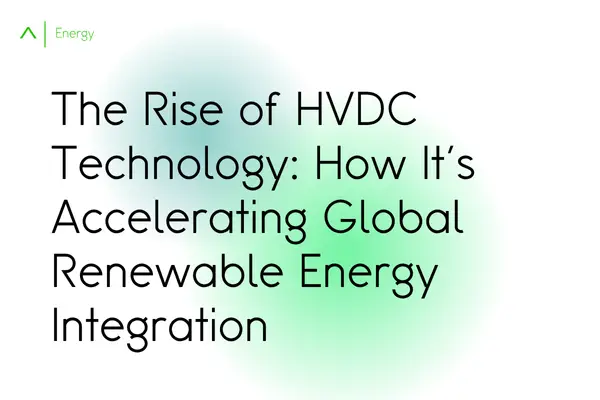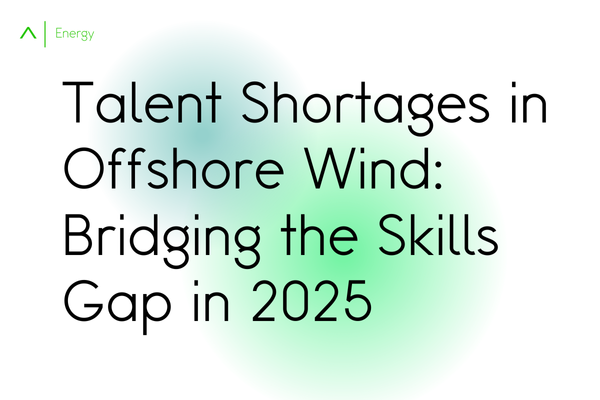The Rise of HVDC Technology: How It's Accelerating Global Renewable Energy Integration
10 Jul, 20253 minsIn 2025, High-Voltage Direct Current (HVDC) technology stands at the forefront of a global e...

In 2025, High-Voltage Direct Current (HVDC) technology stands at the forefront of a global energy transformation. Working in defence recruitment at Mane Defence, I've been observing how the explosive growth in HVDC deployment is creating unprecedented opportunities for professionals across the energy and power systems sector. The convergence of renewable energy ambitions and advanced transmission technology is reshaping entire career landscapes.
The Scale of HVDC Expansion
The numbers tell a compelling story. Since 2020, the HVDC market has maintained a compound annual growth rate of approximately 11%, far exceeding global GDP growth. By 2025, cumulative VSC HVDC capacity has surpassed 50 GW globally, with over 35 GW of new capacity commissioned between 2020 and 2028 alone. This represents a doubling of capacity additions compared to the previous decade.
What makes this expansion particularly significant for talent acquisition is that HVDC is no longer limited to niche applications. Modern projects routinely involve 1.8-2 GW bipole systems operating at 525 kV, demonstrating the technology's maturation into mainstream transmission infrastructure.
Technology Evolution Driving Opportunities
The evolution from thyristor-based Current Source Converter (CSC) systems to advanced Voltage Source Converter (VSC) technology has fundamentally changed the skill requirements in this sector. VSC HVDC systems offer superior controllability, reduced environmental footprint, and enhanced grid stabilisation capabilities.
This technological leap creates immediate demand for professionals who understand IGBT technology, multilevel converter systems, and advanced power electronics. The ability to design, operate, and maintain these sophisticated systems requires expertise that bridges traditional power engineering with cutting-edge electronics.
Offshore Wind Integration: The Primary Driver
Perhaps nowhere is HVDC's transformative impact more evident than in offshore wind integration. The 1400 MW Viking Link, the world's longest interconnector at 765 km, demonstrates how HVDC enables connection of remote renewable resources to demand centres with minimal transmission losses.
Projects like Dogger Bank A have pioneered lean, unmanned offshore HVDC station concepts, using 66 kV direct connections to drive down costs further. These innovations create opportunities for professionals with expertise in offshore engineering, unmanned systems operation, and cost-optimised design approaches.
Multi-Terminal and Hybrid Systems
The emergence of multi-terminal HVDC systems represents a paradigm shift toward true HVDC overlay grids. Projects like the Scottish Caithness-Moray-Shetland extension and the planned Bornholm multi-terminal system demonstrate how HVDC is evolving beyond point-to-point connections.
Hybrid interconnectors combining offshore wind export with market interconnection functionality, such as the LionLink between the UK and Netherlands, create demand for professionals who understand complex multi-purpose infrastructure design and operation.
Grid Stabilisation and Black-Start Capabilities
Modern VSC HVDC systems provide far more than power transmission. They offer voltage stabilisation, reactive power support, and critically important black-start capabilities for grid restoration after major outages. Live full-scale black-start demonstrations have proven these capabilities, creating new opportunities for grid stability specialists.
This expansion of HVDC functionality creates demand for professionals who understand not just power transmission but grid dynamics, stability analysis, and emergency restoration procedures.
Geographic Expansion and Market Opportunities
While Europe has led HVDC deployment, 2025 has seen significant expansion globally. The US market has experienced a renaissance, with projects like Transwest Express and Champlain Hudson Power Express breaking ground. China continues massive HVDC investments, while emerging markets increasingly recognise HVDC's value for renewable integration.
This geographic expansion creates opportunities for professionals willing to work internationally and understand diverse regulatory environments, grid codes, and operational requirements.
Supply Chain Investment and Manufacturing Opportunities
The massive contract awards, including TenneT's 30 billion EUR framework and National Grid's 59 billion GBP tender, have triggered unprecedented supply chain investments. At least $3.3 billion is being invested globally in new HVDC cable manufacturing facilities and capacity expansions.
These investments create opportunities for manufacturing engineers, quality assurance specialists, and supply chain professionals who understand the unique requirements of HVDC component production.
Advanced Materials and Component Development
The push for higher efficiency and reduced environmental impact drives continuous innovation in HVDC components. Modern converter stations achieve significantly lower electrical losses while requiring smaller land areas, demanding expertise in advanced materials, thermal management, and compact design.
Developments in HVDC circuit breaker technology, critical for multi-terminal systems, create opportunities for specialists in high-voltage switching, fault management, and protection systems design.
Skills in High Demand
Based on current HVDC market expansion, several specialisations are particularly valuable:
- VSC System Engineers: Deep expertise in voltage source converter design, control, and optimisation.
- Offshore Engineering Specialists: Understanding both HVDC technology and offshore installation, operation, and maintenance.
- Grid Integration Experts: Ability to design HVDC systems that enhance rather than complicate existing AC grid operation.
- Multi-Terminal System Designers: Expertise in complex HVDC network design and operation.
- Power Electronics Specialists: Advanced understanding of IGBT technology, multilevel converters, and high-frequency switching.
- Project Management Professionals: Experience managing large-scale, long-duration international infrastructure projects.
- Standards and Interoperability Experts: Understanding international standards and multi-vendor system integration.
Renewable Energy Integration Expertise
The fundamental driver of HVDC growth is renewable energy integration. Professionals who understand how wind patterns, solar irradiance, and grid demand interact with HVDC transmission capabilities are increasingly valuable.
The challenge of connecting remote renewable resources to distant load centres while maintaining grid stability requires specialists who understand both renewable energy characteristics and advanced transmission technology.
Future Technology Developments
Looking ahead, HVDC technology continues evolving. Controllable Line-Commutated Converter (CLCC) technology, combining IGBT and thyristor advantages, represents the latest innovation. Future developments in DC circuit breakers, advanced materials, and artificial intelligence for grid management will create new specialisation opportunities.
The move toward HVDC overlay grids, as envisioned in projects like Italy's HyperGrid and TenneT's Target Grid, suggests long-term career opportunities in large-scale system design and operation.
Environmental and Sustainability Considerations
Modern HVDC projects increasingly emphasise sustainability throughout the lifecycle. From reduced transmission losses to smaller environmental footprints and enhanced renewable integration, sustainability expertise is becoming essential.
This creates opportunities for professionals who understand both technical performance and environmental impact assessment, lifecycle analysis, and sustainable design principles.
Looking Forward
The rise of HVDC technology represents more than incremental improvement in power transmission; it enables the fundamental transformation of global energy systems toward renewable sources. The technology's ability to efficiently transmit power over thousands of kilometres with minimal losses makes previously impossible renewable energy projects economically viable.
For professionals in the energy sector, HVDC represents career opportunities at the intersection of cutting-edge technology and critical infrastructure. The combination of massive investment, technological sophistication, and global expansion creates an environment where HVDC careers can flourish.
The sector's growth trajectory, driven by the urgent need for renewable energy integration and grid modernisation, suggests sustained demand for HVDC expertise well into the 2030s and beyond. For those ready to embrace this technology's complexity and potential, the opportunities are genuinely transformational.


